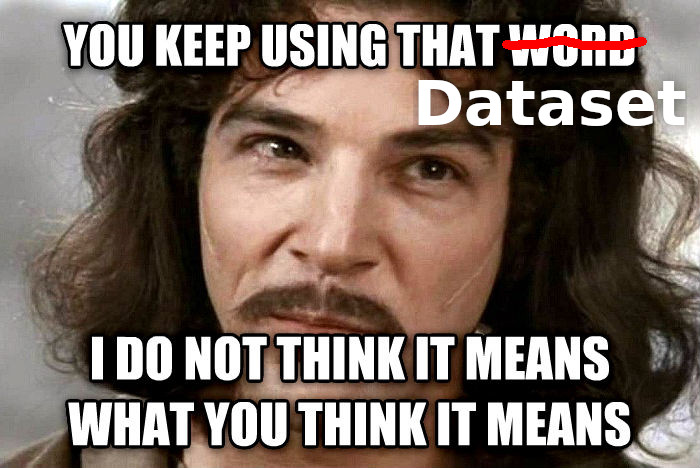 VizierDB
VizierDB
Safe, Reusable Heuristic Data Transformation
(through Caveats)
Oliver Kennedy okennedy@buffalo.edu
Story Time!
Act 1
Alice wants to analyze two unaligned time series.
| Time | Reading |
|---|---|
| 1575731001 | 0 |
| 1575731014 | 0 |
| 1575731030 | 0 |
| 1575731035 | 0 |
| ... | |
| 1575731219 | 1 |
| 1575731229 | 1 |
| 1575731240 | 1 |
| Time | Reading |
|---|---|
| 1575731011 | 0 |
| 1575731020 | 0 |
| 1575731031 | 0 |
| 1575731039 | 0 |
| ... | |
| 1575731218 | 1 |
| 1575731228 | 1 |
| 1575731237 | 1 |
Step 1: Line up the readings
Option 1: Do it right

| Lots of active research efforts! |
| ... but Alice is trying to to GSD! |
Alice's Observations
- Readings every ~10s
- Readings are binary
- Readings are incredibly stable
INSERT INTO series_one_buckets
SELECT CAST(time / 10 AS int) AS bucket,
FIRST(reading)
FROM series_one
GROUP BY bucket;
Interpolate missing values
Hand tune around the switchover as-needed
Time taken: < 30 minutes
Enter Bob...
Similar analysis...
... different data
Can Bob re-use Alice's prep+analytics workflow?
Maybe?
- Are readings still every ~10s?
- Is the data still binary?
- Is the data still (relatively) stable?
... and even then, some manual effort is needed!
Bob needs to know Alice's assumptions
(and how to use the workflow)?
Act 2
Carol gets a dataset from Dave
↓
Dave adds new data to the dataset!
Can Carol re-use her workflow?
Maybe?
- Did the data dictionary change?
- Did new errors get introduced?
Carol needs to remember her assumptions about the data and trust that the new data is like the old data
Act 3
Eve needs to load a CSV file
Scenario 1
I'm sorry, I can't do that, Eve.
You have a non-numerical value at position 1252538:24.
Scenario 2
Load Successful!
(btw, 175326 records didn't load)
Heuristics only work most of the time.
Data science is nuanced.
Assumptions can't be avoided!
It's easy to miss an assumption when re-using work.

Wouldn't it be nice if...

Wouldn't it be nice if...
... this is what Bob saw:
Wouldn't it be nice if...
... this is what Carol saw:
| ⚠ |
The data included an unexpected value: 'Non-Hispanic White' The most similar known value is 'White Non-Hispanic' |
Annotate data with warnings.
If you use this value/record,
here's what you need to know!
Caveat Physicus
Why?
Propagation
- Caveats...
- ... can go where the data goes
- Derived values retain caveats on source data.
- ... stop where the data stops
- Irrelevant caveats don't get propagated
Wouldn't it be nice if...
... this is what Eve saw:

What is a Caveat?
A brief digression...
Classical Databases
One database $D$
Each query gets one answer $R \leftarrow Q(D)$
Incomplete Databases
Multiple possible databases $D \in \mathcal D$
(possible worlds)
Queries get a set of possible answers $\mathcal R \leftarrow \{\; Q(D) \;|\; D \in \mathcal D\;\}$
Certain tuples exist in all possible worlds. $$certain(\mathcal R) = \bigcap_{R \in \mathcal R} R$$
Uncertain tuples exist in at least one,
but not all possible worlds. $$uncertain(\mathcal R) = \bigcup_{R \in \mathcal R} R - certain(\mathcal R)$$
(not limited to set semantics)
A caveat is an assumption tied to one or more data elements (cells or rows).
If the assumption is wrong, so is the element.
Alice / Bob
- FIRST may not pick the right value for a bucket with 2+ distinct values.
- Interpolation may not pick the right value for a bucket with 0 values.
Carol / Dave
- The model hyperparameters may not work if the data changes too significantly.
- New values could indicate new data errors that Carol's ingest script hasn't accounted for.
Eve / Hal
- Replacing a parse error with a NULL might not be what Eve expects.
An element has a caveat → The element is uncertain.
... and btw, here's why.
Caveats
- Story Time
- What is a Caveat?
- The Vizier Notebook
- Applying Caveats
- Propagating Caveats
- Caveats Beyond SQL
Demo
Caveats
- Story Time
- What is a Caveat?
- The Vizier Notebook
- Applying Caveats
- Propagating Caveats
- Caveats Beyond SQL
SELECT setting_1, setting_2, estimate
FROM Simulation;
We want to indicate that the estimate column is only accurate if (for example) P ≠ NP.
caveat(value, assumption)
returns value, annotated with assumption.
SELECT setting_1, setting_2,
caveat(estimate, 'Only correct if P ≠ NP')
AS estimate
FROM Simulation;
annotation is just a human-readable string.
Incomplete Databases
caveat() creates 2 sets of possible worlds:
- The assumption holds: value is correct.
- The assumption does not hold: value is unknown.
Alice / Bob
Mark multi-valued buckets (key repair).
SELECT bucket,
CASE WHEN bucket_size > 1 THEN
caveat(reading, 'Picked between two bucket values.')
ELSE reading END AS reading
FROM (
SELECT CAST(time / 10 AS int) AS bucket,
FIRST(reading) AS reading
COUNT(*) AS bucket_size
FROM sensor
GROUP BY bucket;
)
Interpolation is more complex... but similar.
Carol / Dave
Mark unexpected values the model wasn't trained on.
SELECT
CASE WHEN race_ethnicity
IN ('White Non-Hispanic', 'Black Non-Hispanic', /* ... */)
THEN race_ethnicity
ELSE caveat(race_ethnicity,
'Unexpected race_ethnicity: ' & race_ethnicity)
END, /* ... */
FROM R
This check can be automated.
Eve / Hal
SELECT /* ... */,
CASE WHEN CAST(salary AS float) IS NULL THEN
caveat(NULL, 'Could not cast [ '&salary&' ] to float.')
ELSE CAST(salary AS float) END AS salary
FROM raw_csv_data;
Caveats
- Story Time
- What is a Caveat?
- The Vizier Notebook
- Applying Caveats
- Propagating Caveats
- Caveats Beyond SQL
Has anyone asked about "where" provenance?
Another brief digression...
Value Annotations
Provenance in Databases: Why, How, and Where
James Cheney, Laura Chiticariu and Wang-Chiew Tan
MONDRIAN: Annotating and Querying Databases through Colors and Blocks.
Floris Geerts, Anastasios Kementsietsidis, Diego Milano
and more...
Value Annotations
CREATE VIEW Q AS
SELECT R.A AS X,
R.B+R.C AS Y
FROM R
$$annot(\texttt{Q.X}[i]) \leftarrow annot(\texttt{R.A}[i])$$
$$annot(\texttt{Q.Y}[i]) \leftarrow annot(\texttt{R.B}[i]) \cup annot(\texttt{R.C}[i])$$
Value Annotations
CREATE VIEW Q AS
SELECT R.A AS X,
SUM(R.B) AS Y
FROM R
$$annot(\texttt{Q.X}[i]) \leftarrow \bigcup_{j\;:\;\texttt{R.A}[j] = Q.A[i]} annot(\texttt{R.A}[j])$$
$$annot(\texttt{Q.Y}[i]) \leftarrow \bigcup_{j\;:\;\texttt{R.B}[j] = Q.B[i]} annot(\texttt{R.B}[j])$$
... not the semantics we want
Caveats on $\texttt{R.A}$ also affect $\texttt{Q.B}$.
Caveats ≠ Value Annotations
Certain Data Elements: Elements guaranteed to be in the result in all possible worlds.
... i.e., elements unaffected by the choice of possible world.
If a caveatted element can't affect an output element, don't propagate its caveats!
Propagate caveats to any data elements that could be affected by a change in assumptions.
Challenge: How do we propagate caveats
without penalizing query evaluation?
Don't!
Staged Caveat Discovery
- Alongside query evaluation...
- Instrument queries to discover which elements are affected by a caveat.
- After query evaluation...
- Enumerate specific caveats affecting those elements.
Marking Caveatted Elements

Enumerating Caveats

Instrumenting Queries
≅ computing certain answers! (CoNP-Complete)
Conservative Approximation
Correctness of SQL Queries on Databases with Nulls.
Paolo Guagliardo, Leonid Libkin
Uncertainty Annotated Databases - A Lightweight Approach for Approximating Certain Answers
Su Feng, Aaron Huber, Boris Glavic, Oliver Kennedy
- Unmarked rows are guaranteed to be caveat-free.
- Marked rows might not be caveatted.
Add and maintain a binary "has caveat"
column for each row/column.
CREATE VIEW survey_responses AS
SELECT language,
CASE WHEN CAST(salary AS float) IS NULL THEN
caveat(NULL, 'Could not cast [ '&salary&' ] to float.')
ELSE CAST(salary AS float) END AS salary
FROM raw_csv_data;
CREATE VIEW survey_responses AS
SELECT language, CAST(salary AS float) AS salary,
FALSE AS _caveat_field_language,
CAST(salary as float) IS NULL AS _caveat_field_salary
FALSE AS _caveat_row
FROM raw_csv_data;
SELECT salary
FROM survey_responses
WHERE language = 'Scala'
SELECT salary,
_caveat_field_salary AS _caveat_field_salary,
_caveat_row AND _caveat_field_language AS _caveat_row
FROM survey_responses
WHERE language = 'Scala'
SELECT AVG(salary) AS salary
FROM survey_responses
SELECT AVG(salary),
GROUP_OR(_caveat_field_salary
OR _caveat_row) AS _caveat_field_salary,
FALSE AS _caveat_row
FROM survey_responses
SELECT language, AVG(salary) AS salary
FROM survey_responses
GROUP BY language
SELECT GROUP_OR(_caveat_field_language)
FROM survey_responses
Can often be evaluated statically.
If GROUP BY has caveats
SELECT language, AVG(salary) AS salary
FALSE AS _caveat_field_language
TRUE AS _caveat_field_salary
GROUP_AND(_caveat_field_language OR
_caveat_row) AS _caveat_row
FROM by_language
GROUP BY language
If no GROUP BY caveats
SELECT language, AVG(salary) AS salary
FALSE AS _caveat_field_language
GROUP_OR(_caveat_field_salary,
_caveat_row) AS _caveat_field_salary
GROUP_AND(_caveat_row) AS _caveat_row
FROM by_language
GROUP BY language
Enumerating Caveats
- Static Analysis
- Which caveats could possibly affect the element?
- Dynamic Analysis
- Which specific caveats affect the element?
Static Analysis
What calls to caveat() appear in the derivation of the specified element?
Analogous to program slicing.
Program Slicing
Eliminate lines of code not relevant
to computing a specific value.
This is exactly what a database optimizer does.
Lookup: Caveats on $\texttt{R.A}[i]$
SELECT A
FROM R
WHERE ROWID = i
All calls to caveat() surviving optimization
(probably) affect the target.
Dynamic Analysis
- For each call to caveat(), isolate a query to generate the message.
- Union the message query results together.
Isolate the message
WITH data_source AS
SELECT caveat(A, 'valid if '& B &' is within tolerances.') AS A,
C, D, E
FROM R
SELECT C, D, E FROM data_source WHERE ROWID = i
becomes
SELECT 'valid if '& B &' is within tolerances.'
AS caveat_message
FROM R WHERE ROWID = i
Caveats
- Story Time
- What is a Caveat?
- The Vizier Notebook
- Applying Caveats
- Propagating Caveats
- Caveats Beyond SQL
- Oliver
- I have this great tool for tracking assumptions!
- Data Scientist
- Super! How does it work?
- Oliver
- Well you just write a SQL query...
- Data Scientist
- ...
Caveats for the Masses
| ✔ | SQL |
| ✔ | R (sort of) |
| 🗶 | Spreadsheets |
| 🗶 | Python |
The Exception That Improves The Rule
Juliana Freire, Boris Glavic, Oliver Kennedy, Heiko Mueller
Vizual
Spreadsheet Operations → SQL DDL / SQL DML
- Edit Cell A3 to 'foo'
- UPDATE R SET A = 'foo' WHERE ROWID = 3;
- Insert Row
- INSERT INTO R() VALUES ();
- Insert Column `bar`
- ALTER TABLE R ADD COLUMN `bar`;
Ok... so we have an edit history in DDL/DML.
Caveats on DDL/DML
DDL → SQL
Using Reenactment to Retroactively Capture Provenance for Transactions
Bahareh Sadat Arab, Dieter Gawlick, Vasudha Krishnaswamy, Venkatesh Radhakrishnan, Boris Glavic
DML → SQL
Graceful database schema evolution: the PRISM workbench
Carlo Curino, Hyun Jin Moon, Carlo Zaniolo
UPDATE R SET A = 'foo' WHERE ROWID = 3;
SELECT CASE ROWID
WHEN 3 THEN 'foo'
ELSE A END AS A,
B, C, /* ... */
FROM R
INSERT INTO R() VALUES ();
SELECT * FROM R
UNION ALL
SELECT NULL AS A, NULL AS B,
NULL AS C, /* ... */
ALTER TABLE R ADD COLUMN `bar`;
SELECT *, NULL as `bar` FROM R;
 https://vizierdb.info
https://vizierdb.info
$> pip3 install --user vizier-webapi
$> vizier
| Students | ||||
|---|---|---|---|---|

Poonam |

Will |

Aaron |
||
| Dev |
|---|

Mike |
| Alumni | ||||||
|---|---|---|---|---|---|---|

Ying |

Niccolò |

Arindam |

Shivang |

Olivia |

Gourab |
|
| External Collaborators | |||||
|---|---|---|---|---|---|
|
Zhen Hua Liu (Oracle) |
Ying Lu (Oracle) |
Beda Hammerschmidt (Oracle) |
Boris Glavic (IIT) |
Su Feng (IIT) |
|
|
Juliana Freire (NYU) |
Heiko Mueller (NYU) |
Sonia Castelo Quispe (NYU) |
Carlos Bautista (NYU) |
Remi Rampin (NYU) |
Vizier is supported by NSF Awards ACI-1640864 and #IIS-1750460 and gifts from Oracle
Optimizations
- Too Much Information
- Limit the number of messages returned per call.
- Unions (on Spark) are Expensive
- Execute each query individually in parallel.